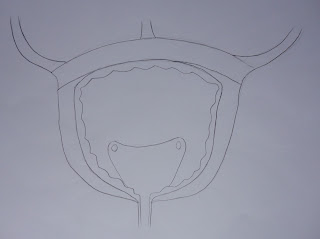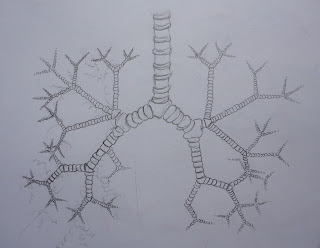The Common Cold
A viral infectious disease of the upper respiratory tract which effects primarily the nose.
Symptoms- cough, sore throat, runny nose fever which usually resolve in seen to ten days, some with symptoms lasting up to three weeks.
Symptoms are mostly due to the body's immune response to the infection rather than to tissue destruction by the viruses themselves.
There is no cure for the common cold.
The average adult contracts colds two or three times a year. The average child between six and twelve times a year
A sore throat is present in about 40% of the cases and a cough in about 50%
In adults a fever is generally not present but it is common in infants and children
While a cough and fever indicates a higher likelihood of influenza in adults, a great deal of simularity exists between these two conditions
A cold normally begins with fatigue, a feeling of being chilled, sneezing and a headache, followed in a couple of days by a runny nose and cough
Symptoms may begin within 16 hours of exposure and typically peak two to four days after onset. They usually resolve in seven to ten days but some can last up to three weeks.
In children the cough last for more than ten days in 35-40% of the cases and continues for more than 25 days in 10%.
Some of the viruses that cause the common cold are seasonal, occurring more frequently during cold or wet weather.
Severe complications if they occur, are usually in the very old, the very young or those who are immunosuppressed. Secondary bacteria infections may occur resulting in sinusitis, pharyngitis, or an ear infection.
It is estimated that sinusitis occurs in 8% and an ear infection in 30% of cases.
Pneumonia can follow.
Influenza
Most common symptoms are chills, fever, sore throat, muscle pains, headache (often severe), coughing, weakness/fatigue and general discomfort.
Influenza may produce nausea and vomiting, particularly in children.
Flu can occasionally lead to pneumonia, even for persons who are usually very healthy.
In particular it is a warning sign if a child for presumably an adult seems to be getting better and then relapses with a high fever.
Another warning sign is if the person starts to have trouble breathing
The first symptoms are chills or a chilly sensation, but fever is also common early in the infection, with body temperatures ranging from 38-39. Many people are so ill they are confined to bed for several days, with aches and pains throughout their bodies, which are worse in their backs and legs.
Symptoms-
- Fever and extreme cold (chills shivering, shaking (rigor))
- Cough
- Nasal congestion
- Body aches, especially joints and throat
- Fatigue
- Headache
- Irritated, watery eyes
- Reddened eyes, skin (face), mouth, throat and nose
- Petechial rash
- In children, gastrointestinal symptoms such s diarrhea and abdominal pain (may be severe in children with influenza)
Can be hard to distinguish between the common cold and influenza in the early stages of these infections, but a flu ca identifies by a high fever with a sudden onset and extreme fatigue.
Diarrhea is not normally a symptom of influenza in adults.
Gastroenteritis
Is a medical condition characterized by inflammation of the gastrointestinal tact that involves both the stomach and small intestine, resulting in some combination of diarrhea, vomiting and abdominal pain and cramping.
Transmission may occur due to consumption of improperly prepared foods of contaminated water via close contact with individuals who are infectious.
Gastroenteritis typically involves both diarrhea and vomiting, or less commonly, presents with only one or the other.
Signs and symptoms usually begin 12-72 hours after contracting the infectious agent
If due to a viral agent, the condition usually resolves within one week.
Some viral causes may also be associated with fever, fatigue, headache and muscle pain.
Children infected with this usually make a full recovery within three to eight days.
There are many causes of gastroenteritis; most numerous cases are caused by viruses, followed by bacteria and other agents.
Food Poisoning
Food poisoning is an illness caused by eating contaminated food - most people will get better without the need for treatment.
In most cases, the food that causes the illness has been contaminated by bacteria, such as salmonella or E.coli , or a virus, such as the norovirus.
The symptoms of food poisoning usually begins one to three days after eating contaminated food. They include feeling sick, vomiting, diarrhea and stomach cramps.
Foods that are particularly vulnerable to contamination if they are not handled, stored or cooked properly include raw meat, and poultry, 'read to eat' foods such as cooked sliced meats, pate, soft cheeses and prepacked sandwiches, dairy products, such as eggs and milk.
Symptoms of the food poisoning depend on the type of contaminant and the amount eaten. The symptoms can develop rapidly within 30 minutes, or slowly, worsening over days to weeks.
Usually food poisoning is not serious, and the illness runs its course in 24-48 hours
Tonsilitus
Is an acute swelling and irritation (inflammation) of the tonsils. Tonsilitus is caused by a bacterial infection or a viral infection.
Tonsils are two glands located in the back of the throat. They belong to the lymphatic system and the immune system and help to protect the body from upper respiratory infections.
Especially important n young children
Can occur to anyone with tonsils but is most common in children.
Th throat and tonsils become red, swollen and white patches of pus may appear on the tonsils.
Other symptoms include pain when swallowing, difficulty swallowing, headache fever and swollen glands.
Contagious and spread when an infected person talks, coughs or sneezes. This shoots droplets contaminated with bacteria or a virus into the air where hey can be breathed in by others.
Sinusitis
Inflammation of the paranasal sinuses, which may be due to infection, allergy, or autoimmune issues. Most cases are due to a viral infection and resolve over the course of 10 days.
It is a common condition; for example, in the US more than 24 million cases occur annually.
It is defined as an inflammation of the mucous membrane that lines the paranasal sinuses and is classified chronologically into several categories.
Acute sinusitis is very common. Roughly 90% of adults have had sinusitis at some point in their life.
Symptoms-
- Headache/facial pain or pressure of a dull, constant, or aching sort over the affected sinuses in common. This pain is typically localized to the involved sinus and may worsen when the affected person bends over or when lying down. Pain often starts on one side of the head and progresses to both sides.
- This may be accompanied by thick nasal discharge that is usually green in colour.
- Often a localized headache or toothache is present, and it is these symptoms that distinguish a sinus-related headache from oth types of headaches, such as tension or migrane headaches
Sinus infections can also cause inner ear problems due to the congestion of nasal passages. This can be demonstrated by dizziness, 'a pressurized or heavy head', or vibrating sensations in the head.
Ear Infections
Otitis - a general term for inflammation or infection of the ear.
Otitis externa involves the outer ear and ear canal. In external otitis the ear hurts when touched or pulled.
In otitis media or middle ear the ear is infected or clogged with flud behind the ear drum, in the normally air filed middle ear space. this very common childhood infection sometimes require a surgical procedure called myringotomy and tube insertion.
Otitis interna involves the inner ear. The inner ear includes sensory organs for balance and hearing. When the inner ear is inflamed, vertigo is a common symptom.
Ear infection is common in children, but can occur at any age. The main symptoms are ear ache and feeling unwell. Painkillers are the main treatment.
The small space behind the eardrum in the middle ear is normally filled with air. It is connected to the back of the throat by a tiny channel called the Eustachian tube.
The middle ear space sometimes becomes filled with mucus(fluid) often during a cold. The mucus may then become infected by bacteria or viruses.
Children with glue ear who have mucus behind their eardrum are more prone to ear infections. Sometimes an ear infection occurs 'out of the blue' for no apparent reason.
Symptoms-
- Earache is common, but does not always occur
- Dulled hearing may occur for a few days
- Fever is common
- Children may feel sick or vomit
- Sometimes the eardrum perforates (bursts). this lets out infected mucus and the ear becomes runny for a few days. As the pain of earache is due to a tense eardrum, a burst eardrum often relieves pain. A perforated eardrum usually heals within a few weeks after the infection clears.
Most bouts of ear infection will clear on their own without treatment within 2-3 days.
Pharyngitis
Inflammation of the throat. In most cases it is quite painful, and it is the most common cause of a sore throat.
Pharyngitis can result in very large tonsils which cause trouble swallowing and breathing. Pharyngitis can be accompanied by a cough or fever.
Pharyngitis is a ype of inflammation, most commonly caused by an upper respiratory tract infection.
Pneumonia
Pneumonia is an inflammatory condition of the lung - specially affecting the microscopic air sacs (alveli) associated with fever, chest symptoms and a lack of airspace o a chest xray. Pneumonia is typically caused by an infection but the are a number of other causes.
Typical symptoms include cough, chest pain, fever and difficulty breathing.
People with infectious pneumonia often have a production cough, fever accompanied by shaking chills, shortness of breath, sharp or stabbing chest pain during deep breaths, confusion, and an increased respiratory rate.
In the elderly confusion may be the most prominent sign. The typical signs and symptoms in children under five are fever, cough, and fast or difficult breathing.
Due to primarily infections, with less common causes including irritants and the unknown.
Shingles
Herpes Zoster, commonly known s shingles and also known as Zona, is a viral disease characterized by a painful skin rash with blisters in a limited area on one side of the body, often in a stripe.
The initial infection causes the acute illness chicken pox which generally occurs in children and young people. Once an episode has resolved, the virus is not eliminated from the body but can go on to cause shingles - an illness with very different symptoms - often many years after the initial infection.
Years or decades after a chicken px infection, the virus may break out of nerve cell bodies and travel down nerve axons to cause viral infection of the skin in the region of the nerve. the virus may spread from one or more ganglia along nerves of an affected segment and infect the corresponding dermatone (an area of skin supplied by one spinal nerve) causing a painful rash. Although the rash usually heals within two to four weeks, some sufferers experience residual nerve pain for months or years, a condition called postherpetic neuralgia.
The earliest symptoms include headache, fever and malaise are non specific, and may result in an incorrect diagnosis. these symptoms are commonly followed by sensations of burning pain, itching, oversensitivity or pins and needles, tingling, prickling or numbness. The pain maybe mild.




















































